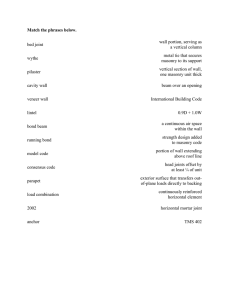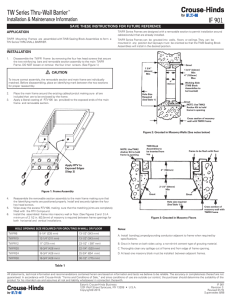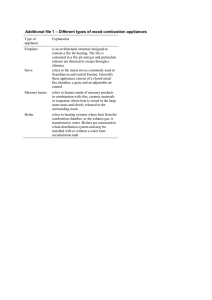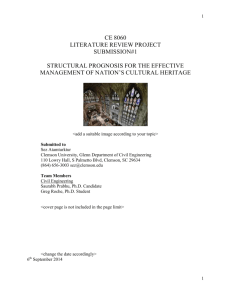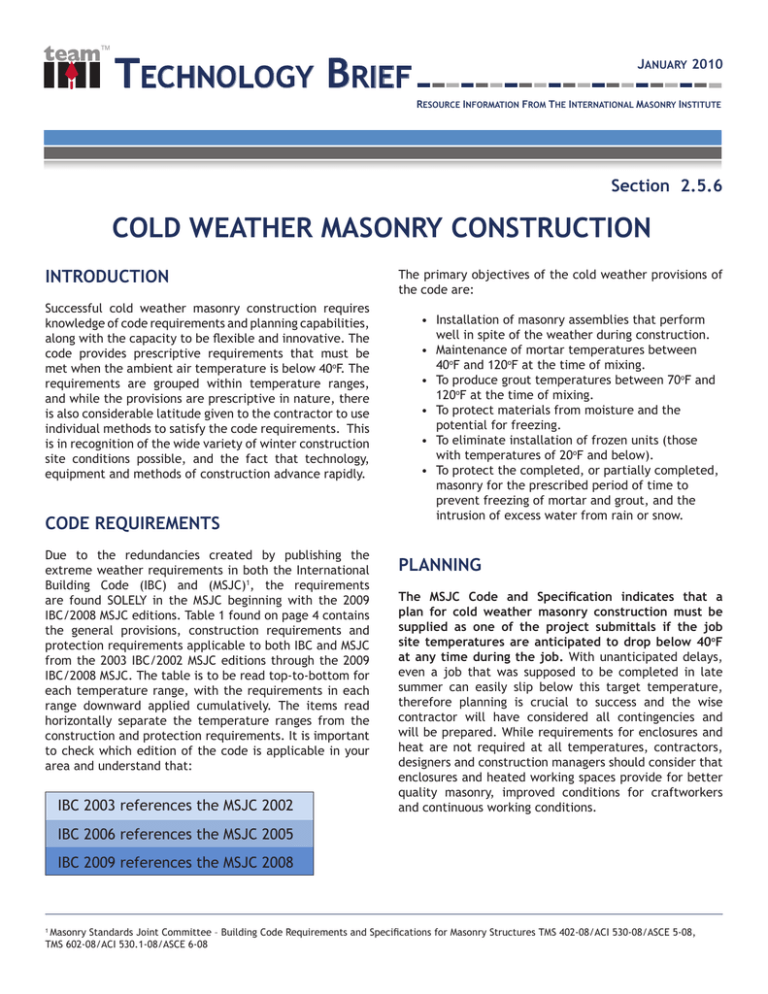
TM
TECHNOLOGY BRIEF
JANUARY 2010
RESOURCE INFORMATION FROM THE INTERNATIONAL MASONRY INSTITUTE
Section 2.5.6
Cold Weather Masonry Construction
INTRODUCTION
Successful cold weather masonry construction requires
knowledge of code requirements and planning capabilities,
along with the capacity to be flexible and innovative. The
code provides prescriptive requirements that must be
met when the ambient air temperature is below 40oF. The
requirements are grouped within temperature ranges,
and while the provisions are prescriptive in nature, there
is also considerable latitude given to the contractor to use
individual methods to satisfy the code requirements. This
is in recognition of the wide variety of winter construction
site conditions possible, and the fact that technology,
equipment and methods of construction advance rapidly.
Code Requirements
Due to the redundancies created by publishing the
extreme weather requirements in both the International
Building Code (IBC) and (MSJC)1, the requirements
are found SOLELY in the MSJC beginning with the 2009
IBC/2008 MSJC editions. Table 1 found on page 4 contains
the general provisions, construction requirements and
protection requirements applicable to both IBC and MSJC
from the 2003 IBC/2002 MSJC editions through the 2009
IBC/2008 MSJC. The table is to be read top-to-bottom for
each temperature range, with the requirements in each
range downward applied cumulatively. The items read
horizontally separate the temperature ranges from the
construction and protection requirements. It is important
to check which edition of the code is applicable in your
area and understand that:
IBC 2003 references the MSJC 2002
The primary objectives of the cold weather provisions of
the code are:
•
•
•
•
•
•
Installation of masonry assemblies that perform well in spite of the weather during construction.
Maintenance of mortar temperatures between 40oF and 120oF at the time of mixing.
To produce grout temperatures between 70oF and 120oF at the time of mixing.
To protect materials from moisture and the potential for freezing.
To eliminate installation of frozen units (those with temperatures of 20oF and below).
To protect the completed, or partially completed,
masonry for the prescribed period of time to prevent freezing of mortar and grout, and the intrusion of excess water from rain or snow.
Planning
The MSJC Code and Specification indicates that a
plan for cold weather masonry construction must be
supplied as one of the project submittals if the job
site temperatures are anticipated to drop below 40oF
at any time during the job. With unanticipated delays,
even a job that was supposed to be completed in late
summer can easily slip below this target temperature,
therefore planning is crucial to success and the wise
contractor will have considered all contingencies and
will be prepared. While requirements for enclosures and
heat are not required at all temperatures, contractors,
designers and construction managers should consider that
enclosures and heated working spaces provide for better
quality masonry, improved conditions for craftworkers
and continuous working conditions.
IBC 2006 references the MSJC 2005
IBC 2009 references the MSJC 2008
Masonry Standards Joint Committee – Building Code Requirements and Specifications for Masonry Structures TMS 402-08/ACI 530-08/ASCE 5-08,
TMS 602-08/ACI 530.1-08/ASCE 6-08
1
Cold Weather MasonryAIR
Construction
BARRIER UPDATE- -page
page 2
Understanding Temperature
Ranges
Both the MSJC and the IBC make a clear distinction between
the construction requirements and the post-construction
protection provisions for cold weather masonry work.
•
•
•
Construction-phase temperature ranges are based
on ambient temperatures, that is, the temperature
at the site at the time of construction.
Post-construction protection requirements are based on anticipated daily minimum temperatures
for grouted masonry, the forecast low for the
upcoming 24- or 48-hour period, depending on what
type cement is used in the grout.
Post-construction protection for ungrouted masonry
is based on anticipated mean daily temperatures,
that is, the forecast average temperature for the
upcoming 24-hour period.
Many contractors will use the more conservative
anticipated daily minimum temperature for both grouted
and ungrouted masonry to simplify their planning for the
next day’s work, even though it may be slightly more
restrictive.
Heating Materials
The code allows heating water and/or aggregates to
achieve the required mortar temperatures at the time of
mixing. At the temperature range of 40oF to 32oF heating
either the sand OR the water is expected to produce the
desired result of mortar between 40oF and 120oF. At the
next temperature range, below 32o to 25oF, heating BOTH
sand and water is needed to accomplish the goal. Below
25oF, not only do the sand and water require heating,
but any masonry surface under construction must be at
least 40oF and wind breaks are required if the wind speed
exceeds 15 mph. Below 20oF, an additional requirement
of a heated enclosure is stipulated.
Heating the water is probably the most effective technique
for achieving the desired mortar temperature because of
water’s ability to retain heat and impart it to the other
ingredients. When dry mortar ingredients are delivered
in bulk and mixed from silos, it’s a good practice to at
least partially enclose the silo and provide auxiliary heat
to the silo or the mixing area to keep the dry ingredients
This document is intended for the use of industry professionals
as
warm as possible.
Heated mortar silo enclosure.
Heating work areas
Heating the enclosure may be viewed as an expensive
requirement, but considering that it may be used to keep
the materials warm, as well as the craftworkers, it is
probably a good investment. The increased productivity
from masons who are working in a protected and warmer
environment can be a side benefit of the code provision.
Additionally, if it means being able to close out the job
sooner rather than shut down and complete it later, it
could mean savings in the long run.
Winter protection for smaller masonry jobs, or smaller
areas of large ones, can be a move-as-you-go enclosure.
who are competent to evaluate the significance and limitations of
the information provided herein. This publication should not be used as the sole guide for masonry design and construction, and
IMI disclaims any and all legal responsibility for the consequences of applying the information.
Caution must be taken to not overheat the water or sand,
as sand that’s too hot can scorch causing discoloration
of the mortar, and water that’s too hot can cause flash
setting of the mortar – both undesirable consequences.
International Masonry Institute
42 East Street
Annapolis, MD 21401
IMI 2009.
ALL RIGHTSand
RESERVED.
Weather
protection
heated enclosures are a
good investment.
C
1-800-IMI-0988
www.imiweb.org
Cold Weather MasonryAIR
Construction
BARRIER UPDATE- -page
page 3
2
Keeping materials dry
Keeping materials dry and free of ice and snow may require
no more than storing them on pallets covered with a heavy
tarp. The code prohibits laying units with visible ice or
snow, or those having a temperature of 20oF or less. While
there are many low-tech methods of removing the ice,
“torching” the units can be risky, as it could cause thermal
shock, resulting in cracked units. Moving the proper
number of units into the heated enclosure at the end of
the day will provide warmed units for work, but requires
an accurate prediction of productivity and adequate
interior storage space. Pre-warming the masonry units
in a separate enclosure may be an attractive option when
combined with “just-in-time” delivery to the scaffold.
While it may appear more expensive, the practice may
result in time saved from removing ice and snow from units
exposed to the weather, and a better end product might
result that could cost less overall. Additionally, proper
protection of materials complies with LEED IEQ Credit 3.1,
Construction Indoor Air Quality Management Plan, that
calls for the protection of construction materials from
moisture damage.
Protection
Under the general requirements for construction, the
code requires that all completed, or partially completed
masonry must be covered at the end of the day. This is
required regardless of the job site temperature when the
masonry is not inside a covered enclosure. This commonsense protection provision helps prevent efflorescence due
to excess water and other contaminants from entering the
system, either from the top or the side.
These brick are not properly protected. Protect
masonry units from ice and snow and keep dry.
Do not torch units
to remove snow
and ice. Thermal
shock could crack
masonry units.
The requirements for the post-construction protection
of grouted vs ungrouted masonry described in the
Understanding Temperature Ranges section of this
document can be confusing because of the differing time
periods involved for each, and whether Type III cement
has been used in the grout. As indicated in Table 1, the
basis for protection requirements for ungrouted masonry is
the mean daily temperature at the construction site, that
is, the average temperature forecast for the upcoming
24-hour period. Grouted masonry protection, on the
other hand, is based on the anticipated daily minimum
temperature forecast for 24, or 48, hours. For example, if
the average low temperature forecast is to be below 25oF,
the
Type
IIIof
cement
has
been used who are competent to evaluate the significance and limitations of
This masonry
documentisisgrouted,
intended and
for the
use
industry
professionals
thethe
information
provided herein.
This publication
not be used as the sole guide for masonry design and construction, and
in
grout, protection
is only required
for theshould
completed
IMI disclaims
all legal
forofthe
consequences
masonry
for any
24 and
hours.
If a responsibility
different type
cement
has of applying the information.
been used, the protection period is 48 hours. Ungrouted
C IMI 2009. ALL RIGHTS RESERVED.
masonry, however, only needs the protection of insulating
blankets for 24 hours.
International Masonry Institute
42 East Street
Protect
and
finished
work.
AIR
BARRIER
UPDATE
- page 2
Annapolis,
MDunfinished
21401
1-800-IMI-0988
www.imiweb.org
As indicated in Table 1, the basis for protection requirements for ungrouted masonry is the mean daily temperature at the
construction site, that is, the average temperature forecast for the upcoming 24-hour period. Grouted masonry protection
is based on the anticipated daily minimum temperature
forecast for Masonry
24 hours, or 48
hours.
For example,
if the
masonry
AIR
BARRIER
UPDATE
page
2
Cold Weather
Construction
- -page
4
is grouted and Type III cement has been used in the grout, protection is only required for the completed masonry for 24
hours. If another Type of cement has been used, the protection period is 48 hours. Ungrouted masonry only needs the
The reason for extended protection for grouted masonry
Use cold weather requirements
protection of insulating blankets for 24 hours.
below 25oF is to avoid any possibility of the mortar or
from one source
grout freezing. Frozen mortar and grout will develop
Planning
microscopic fissures from the water expanding as it
Since
the for
format
the requirements
is slightly different
Section 1.8C
of the
MSJC
andcompressive
Specification
indicates that
a plan
coldofweather
masonry construction
must be
freezes.
This can
result
in Code
reduced
strength
o such as the 2008 MSJC
in
different
places,
use
one
source
supplied
as oneproper
of the project
if the job site conditions are anticipated to drop below 40 F at any time during the
and
can inhibit
bondingsubmittals
of materials.
additional
resources
available,
thewinter.
table
job. With unanticipated delays, even a job that was supposed but
to behave
completed
in late
summer
can easilysuch
slipas
into
below.
The
requirements
in
the
table
simply
organize
the
Admixtures
used to
accelerate
mortar
setting
are
Therefore, planning
is crucial
to success
and the
wise contractor
will have considered all contingencies and will be prepared.
information
from
the
MSJC
in
a
convenient
tabular
form.
sometimes
used, requirements
but only withforgreat
caution,
some
While protection
enclosures
andas
heat
may not be required at certain temperatures, contractors, designers
can
corrosion
of imbedded
metals. that
In addition,
andcause
construction
managers
should consider
enclosures and heated working space provide for better quality masonry,
admixtures
of
any
kind
may
ONLY
be
used
with working
the
improved conditions for craftworkers and continuous
conditions. Cold weather masonry can affect productivity,
permission
of
the
design
professional
of
record.
budgets, support labor and scheduling.
Some planning and construction tips for cold weather masonry:
PERFORMANCE TARGETS
Reduce
grout
slump
grout slump,
especially with low absorption units or units
with
integralfor
water
repellants.
• Reduce
• Be
prepared
when
the ambient temperature
• Use anticipated minimum daily temperatures rather than mean
daily
will temperatures
reach 40oF. to simplify procedures.
Reducing grout slump, especially with low absorption units
o
o
MSJC
Table)
consistency,
but40have
other
• Use cold weather requirements from one source (2002/2005 •
Keep
thefor
mortar
between
F and
120information
F.
or units with integral water repellants, can be a valuable
• Don’t lay frozen units or allow the masonry to
available for reference.
technique because with colder temperatures, there is less
freeze before initial set.
water
to beinformation
lost to the on
atmosphere
and Masonry
units areConstruction,
colder
For further
Cold Weather
contact
IMI atthe
1-800-IMI-0988.
• Protect
masonry from freezing after
so the water in the grout can be more efficiently used for
construction.
• The Masonry
Committee
– Hotlow
andabsorption
Cold Weatherunits
Masonry Construction
hydration
of theIndustry
cement.
With the
• Result: The masonry will perform as expected.
• is
NCMA
3-1C (2002)
this
just TEK
amplified.
The goal during cold weather is to
• BIA Technical Note 1 (1992)
get the grout cured and part of that is absorption of the
water that isn’t needed for hydration.
MSJC (2002 & 2005) Requirements for Cold Weather Construction
Table 1 - MSJC 2002,
2005 andfrom
2008
forcumulative.
Cold Weather Construction
Requirements
top Requirements
to bottom of chart are
General Preparation and Construction Requirements: Store units and other materials in dry conditions off the ground. Do not lay frozen units (those
with temperatures below 20oF (6.7oC) or those with visible ice or snow. Do not heat water or aggregates above 140oF (60oC). It’s not necessary to heat
grout materials unless their temperatures are below 32oF (0oC).
Construction Requirements
Protection Requirements
(Based on mean daily temperatures for ungrouted
masonry and anticipated daily minimums for grouted
masonry for period following construction)
Temperature Ranges
Ambient Temperatures
(Temperatures during construction)
40oF to 32oF
(4.4oC to 0oC)
Do not lay glass units in temperatures below 40oF
(4.4oC). Heat sand or water to achieve mortar temperatures of 40oF (4.4oC) to 120oF (49oC) at time of mixing.
Maintain glass unit masonry above 40oF (4.4oC) for 48
hrs. Protect newly laid masonry with weather-resistant
membrane for 24 hours.
Heat sand and water to achieve mortar temperatures of
40oF (4.4oC) to 120oF (49oC) at time of mixing. Maintain materials above 32oF (0oC) until used. Heat grout
aggregates and water, keeping grout above 70oF (21oC).
Protect newly laid masonry with weather-resistant
membrane for 24 hours.
Add windbreaks or enclosures when wind exceeds 15
mph (24.1 km/h). Heat masonry to 40oF (4.4oC) prior
to grouting.
Cover new masonry completely with insulating blankets, or equal, for 24 hours. Increase to 48 hours for
grouted masonry unless Type III cement only is used.
Add auxiliary heat to enclosures. Keep enclosed area
above 32oF (0oC).
Maintain new masonry temperature above 32oF (0oC)
for 24 hours with heated enclosures, lamps, etc. Increase to 48 hours for grouted masonry unless Type III
cement only is used.
32oF to 25oF
(0oC to to -3.9oC)
25oF to 20oF
(-3.9oC to -6.7oC)
20oF and below
(-6.7oC and below)
This
document
is
the
of
professionals
who
are
competent
to
the
and
limitations
of
This document
is intended
for the usefor
of industry
professionals
who are
competent to evaluate
significance
and limitations
of the information
provided herein.
publication should
This
document
is intended
intended
for
the use
use
of industry
industry
professionals
whothe
are
competent
to evaluate
evaluate
the significance
significance
andThis
limitations
of
the
information
provided
herein.
This
should
not
be
used
as
sole
masonry
and
construction,
and
not be
used as the sole
guide for masonry
design
andpublication
construction, and
IMI disclaims
all legal
responsibility
for thefor
consequences
applying the
information
.
the
information
provided
herein.
This
publication
should
not any
be and
used
as the
the
sole guide
guide
for
masonryofdesign
design
and
construction,
and
IMI
IMI disclaims
disclaims any
any and
and all
all legal
legal responsibility
responsibility for
for the
the consequences
consequences of
of applying
applying the
the information.
information.
©CCIMI
All RIGHTS
Rights Reserved.
IMI 2005.
2009. ALL
RESERVED.
IMI 2009. ALL RIGHTS RESERVED.
International Masonry Institute
International
International Masonry
Masonry Institute
Institute
42 East Street
42
42 East
East Street
Street
Annapolis, MD 21401
Annapolis,
Annapolis, MD
MD 21401
21401
1-800-IMI-0988
1-800-IMI-0988
1-800-IMI-0988
www.imiweb.org
www.imiweb.org
www.imiweb.org

